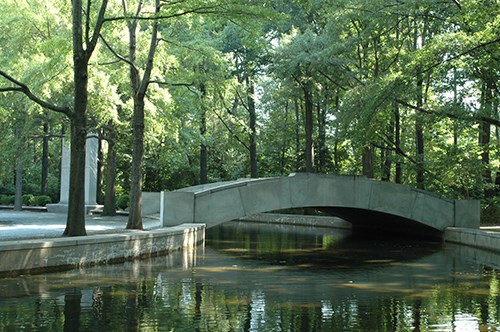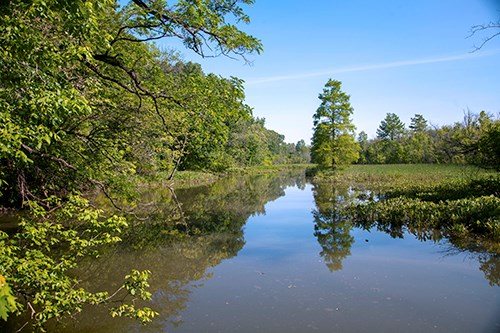Last updated: October 15, 2021
Article
Sense of Wilderness: New Perspectives on Theodore Roosevelt Island

NPS Photo
President Roosevelt was an early champion of public lands as president, serving from 1901 to 1909. He created the United States Forest Service (USFS), signed the 1906 American Antiquities Act, and protected lands for five of today’s national parks and 18 national monuments.
To honor this legacy, landscape architect Frederick Law Olmsted, Jr. designed his memorial landscape to evoke a sense of wilderness. Thirty years later, architect Eric Gugler designed a plaza flanked by two pools and surrounded by a moat, and sculptor Paul Manship created a larger than life statue of Roosevelt.
Theodore Roosevelt Island was the first living presidential memorial in Washington, D.C. This 88.5-acre wooded sanctuary is located in the Potomac River, between Georgetown in Washington, D.C., and Rosslyn, Virginia. Today, it is managed as a part of the National Park Service’s George Washington Memorial Parkway.
A Sense of Place
The park’s multi-sensory nature walk programs make this naturalistically designed landscape accessible to the blind and visually impaired community through touch, sound, smell, and taste. One recent multi-sensory walk began on the Virginia side of the river, where blind, visually impaired, and sighted visitors explored a touch table of Native American cultural and natural artifacts.
The island has a long Native history. English settlers first called it Analostan Island after a local group. During this program, an elder of the Piscataway Conoy tribe talked about its meaning to his people today.

NPS Photo
As they walked deeper into the woods, the sounds of airplanes crossing overhead was the only reminder of being in the city. Much of the island is wooded with native hardwood trees and shrubs, which the designers envisioned growing into a stable climax forest. English ivy and periwinkle are the only non-native species, included for their picturesque effect. Today more recent exotic arrivals like the perilla mint, also called the beefsteak plant, also grow here. Visitors smelled the invasive mint, a fast-growing species used in some Asian cuisines, and touched the roots of a fallen tree that created a window of sunlight for it to grow.
They smelled the leaves of the spicebush, passed around ripe and unripe fruits of the pawpaw tree, and dipped plastic spoons into a jar of pawpaw spiceberry jam made from these two common native plants. They stopped to trace the letters of previous visitors who had carved names and initials into trees - a destructive practice that is not allowed in national parks, but has unfortunately become part of today’s landscape.

NPS Photo
The island’s wild appearance hides its long history of design and transformation, which rangers also discussed during the walk. Between 1792 and 1833, John Mason, the son of Revolutionary George Mason IV, built a house and cleared trees for the fields and gardens of a formal plantation.
The 1st United States Colored Troops trained on the island in 1863 as they prepared to join the Civil War. After 1st USCT was mustered to Richmond, VA, the military established Camp Greene, a refuge for runaway slaves, before disbanding it in the summer of 1865.
After the war, the island shifted from a place where people lived to a place where they played, offering boating, hiking, camping, bicycling, and sports close to the city until 1891, when a fire burned down the Columbia Athletic Club’s clubhouse. During the Spanish-American War, the then-abandoned island was used to test explosives. In 1931, when the Theodore Roosevelt Memorial Association purchased the island to donate to the National Park Service, an observer described it as a garden fallen into ruin. Today’s forest is less than a century old.
Walks like these offer an opportunity for new audiences to immerse themselves in the landscape, its history, and its natural processes, fulfilling Theodore Roosevelt’s wish to preserve America’s natural treasures for future generations. Exploring the resources of a park like Theodore Roosevelt Island through multi-sensory perspectives can make a seemingly simple landscape more rich, complex, and accessible for all.




